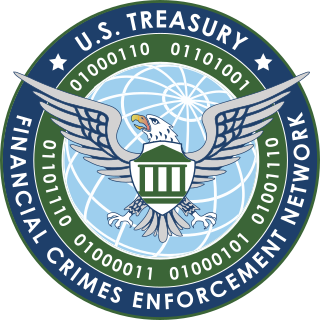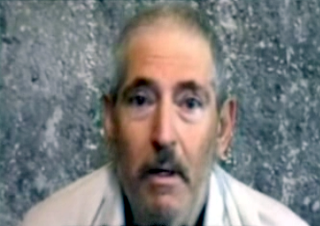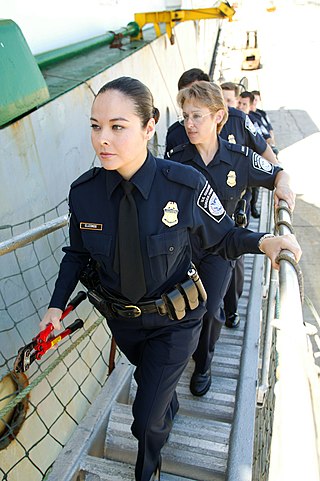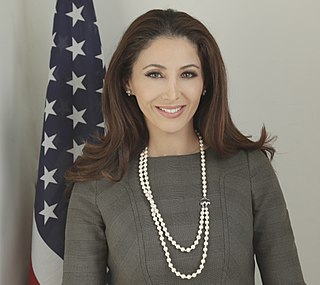Related Research Articles

The Federal Bureau of Investigation (FBI) is the domestic intelligence and security service of the United States and its principal federal law enforcement agency. Operating under the jurisdiction of the United States Department of Justice, the FBI is also a member of the U.S. Intelligence Community and reports to both the Attorney General and the Director of National Intelligence. A leading U.S. counterterrorism, counterintelligence, and criminal investigative organization, the FBI has jurisdiction over violations of more than 200 categories of federal crimes.

The Financial Crimes Enforcement Network (FinCEN) is a bureau of the United States Department of the Treasury that collects and analyzes information about financial transactions in order to combat domestic and international money laundering, terrorist financing, and other financial crimes.

The Hostage Rescue Team (HRT) is the Federal Bureau of Investigation's (FBI) elite tactical unit. The HRT was formed to provide a full-time federal law enforcement tactical capability to respond to major terrorist incidents throughout the United States. Today, the HRT performs a number of tactical law enforcement and national security functions in high-risk environments and conditions and has deployed overseas, including with military Joint Special Operations Command units.

The Bureau of Alcohol, Tobacco, Firearms and Explosives (BATFE), commonly referred to as the ATF, is a domestic law enforcement agency within the United States Department of Justice. Its responsibilities include the investigation and prevention of federal offenses involving the unlawful use, manufacture, and possession of firearms and explosives; acts of arson and bombings; and illegal trafficking and tax evasion of alcohol and tobacco products. The ATF also regulates via licensing the sale, possession, and transportation of firearms, ammunition, and explosives in interstate commerce. Many of the ATF's activities are carried out in conjunction with task forces made up of state and local law enforcement officers, such as Project Safe Neighborhoods. The ATF operates a unique fire research laboratory in Beltsville, Maryland, where full-scale mock-ups of criminal arson can be reconstructed. The ATF had 5,285 employees and an annual budget of almost $1.5 billion in 2021. The ATF has received criticism over its handling of the Ruby Ridge siege, the Waco siege and other incidents.

Ruby Ridge was the site of an 11-day siege of a cabin occupied by the Weaver family in Boundary County, Idaho in August 1992. It began on August 21, when deputies of the United States Marshals Service (USMS) came to arrest Randy Weaver under a bench warrant after his failure to appear on federal firearms charges. During a surveillance operation, officer Art Roderick shot Weaver's dog, leading Weaver's son Sammy to fire at the team. Sammy was then shot and killed, causing an exchange of fire in which Weaver's friend Kevin Harris shot and killed Deputy Marshal William Francis Degan. Weaver, Harris, and members of Weaver's immediate family refused to surrender. The Hostage Rescue Team of the Federal Bureau of Investigation became involved as the siege was mounted. In the standoff, FBI sniper Lon Horiuchi shot Weaver's wife Vicki while she was holding her baby daughter – the only casualty of the siege itself. The conflict was ultimately resolved by civilian negotiators. Harris surrendered and was arrested on August 30; Weaver and his three daughters surrendered the next day.
In the United States, a special agent is an official term used to refer to an investigator or detective for a federal or state government or independent agency, who primarily serves in criminal investigatory positions. Additionally, many federal and state special agents operate in "criminal intelligence" based roles as well. Within the U.S. federal law enforcement system, dozens of federal agencies employ federal law enforcement officers, each with different criteria pertaining to the use of the titles Special Agent and Agent. These titles are also used by many state level agencies to refer to their personnel.

In the United States, a Joint Terrorism Task Forces (JTTF) is a locally-based multi-agency partnership between various federal, state, and local law enforcement agencies tasked with investigating terrorism and terrorism-related crimes, led by the Federal Bureau of Investigation and U.S. Department of Justice. The first JTTFs were established before the September 11 attacks, with their numbers increasing dramatically in the years after.

The Waco siege, also known as the Waco massacre, was the siege by U.S. federal government and Texas state law enforcement officials of a compound belonging to the religious cult known as the Branch Davidians between February 28 and April 19, 1993. The Branch Davidians, led by David Koresh, were headquartered at Mount Carmel Center ranch in unincorporated McLennan County, Texas, 13 miles northeast of Waco. Suspecting the group of stockpiling illegal weapons, the Bureau of Alcohol, Tobacco, and Firearms (ATF) obtained a search warrant for the compound and arrest warrants for Koresh and several of the group's members.

The Organized Crime Drug Enforcement Task Force (OCDETF) is a federal drug enforcement program in the United States, overseen by the Attorney General and the Department of Justice. The principal mission of the OCDETF program is to identify, disrupt, and dismantle the major drug trafficking operations and tackle related crimes, such as money laundering, tax and weapon violations, and violent crime, and prosecute those primarily responsible for the nation's drug supply.
John Gregory "Buster" Ardito was an American caporegime in the Genovese crime family who worked in the Bronx borough of New York.
Special Operations Response Teams are a group under the US Federal Bureau of Prisons, or BOP for short, a component of the US Department of Justice (DOJ). The BOP is responsible for maintaining the custody of anyone convicted of committing a federal crime. To achieve this goal, the BOP maintains a number of correctional facilities, which are divided into six regions, throughout the US. These facilities house approximately 211,195 inmates of varying security levels. Facilities are designated as either minimum, medium, maximum, or the most recent addition, super max.

Robert Alan "Bob" Levinson was an American former Drug Enforcement Administration (1970–1976) and Federal Bureau of Investigation (1976–1998) agent who disappeared on March 9, 2007, in Kish Island, Iran, while on a mission for the Central Intelligence Agency (1998–2007). Levinson's family received a $2.5 million annuity from the CIA in order to stop a lawsuit revealing details of his work in Iran and to forestall any revelation of details regarding the arrangement between Levinson and the agency.
The counter-terrorism page primarily deals with special police or military organizations that carry out arrest or direct combat with terrorists. This page deals with the other aspects of counter-terrorism:

The federal government of the United States empowers a wide range of federal law enforcement agencies to maintain law and public order related to matters affecting the country as a whole.
Kenneth Michael Trentadue was an American citizen who was found hanged in his cell at Federal Transfer Center, Oklahoma City during the investigation of the Oklahoma City bombing. His death was officially ruled a suicide three years after it occurred. Trentadue's family maintains that he was murdered by members of the FBI who mistakenly believed he was involved in the Oklahoma bombing and that officials at the prison engaged in a cover-up. Oklahoma City's chief medical examiner said it was "very likely he was murdered". Convicted bomber Timothy McVeigh stated that he believed Trentadue was mistaken for Richard Lee Guthrie Jr., a suspected co-conspirator in the bombing who also died in federal custody, allegedly from suicide by hanging.
The Afghan Threat Finance Cell was a multi-agency intelligence organization in Afghanistan. The organization was created in 2008. The United States' Drug Enforcement Administration was the lead agency in the organization. The co-deputy agencies were the United States Treasury and the United States Department of Defense. Other participating agencies included the Royal Canadian Mounted Police, the United States Federal Bureau of Investigation, the United States Department of Homeland Security, and the United States Internal Revenue Service.

The Cyber Division (CyD) is a Federal Bureau of Investigation division which heads the national effort to investigate and prosecute internet crimes, including "cyber based terrorism, espionage, computer intrusions, and major cyber fraud." This division of the FBI uses the information it gathers during investigation to inform the public of current trends in cyber crime. It focuses around three main priorities: computer intrusion, identity theft, and cyber fraud. It was created in 2002.

Julia Nesheiwat is an American national security adviser who served as the 10th homeland security advisor in the Trump administration from 2020 to 2021. She also served in the Bush and Obama administrations.
Mark Randall Frerichs is an American civil engineer and former US Navy diver who disappeared in Afghanistan in January 2020 and was later confirmed to be captured by the Haqqani network, a group closely aligned with the Taliban. In September 2022, Frerichs was released by the Taliban-led government of the Islamic Emirate of Afghanistan in exchange for Bashir Noorzai.
References
- ↑ "Hostage Recovery Fusion Cell Established". Federal Bureau of Investigation . 2015-06-15. Retrieved 2020-05-13.
Staffed by hostage recovery professionals from the Department of Defense, Department of State, Department of Justice, the U.S. Department of the Treasury, the FBI, and the intelligence community, the fusion cell aims to improve how the government develops hostage recovery plans, tracks developments in specific cases, shares information with families, and provides information to Congress and the media.
- ↑ Adam Goldman (2016-09-12). "In a Shift, U.S. Includes Families in Hostage Rescue Efforts". The New York Times . p. A1. Retrieved 2020-05-13.
Instead of tackling hostage cases on an ad hoc basis, officials from the Defense and State Departments, the Central Intelligence Agency and the Treasury Department — part of the new group, which is known as the Hostage Recovery Fusion Cell — now gather daily at the F.B.I. headquarters to discuss them.
- ↑ "Hostage Recovery Fusion Cell Marks Third Anniversary: Unified Government Approach Key to Bringing Loved Ones Home to Their Families". Federal Bureau of Investigation . 2018-06-29. Retrieved 2020-05-13.
Since the White House established the fusion cell on June 24, 2015—along with positions including a special presidential envoy for hostage affairs and a family engagement coordinator—the U.S. government has sought to 'speak with one voice' regarding hostage matters, said FBI Special Agent Robert Saale, director of the fusion cell. 'That effort has been extremely beneficial.'
- ↑ "Hostage Recovery Fusion Cell Marks Fifth Anniversary". Federal Bureau of Investigation . 2020-06-24. Retrieved 2020-07-24.
A key aspect of the HRFC is the Family Engagement Team.
- ↑ Seth Loertscher (January 2020). "A View from the CT Foxhole: Rob Saale, Former Director, U.S. Hostage Recovery Fusion Cell". Counter Terrorism Center . Vol. 13, no. 1. Retrieved 2020-07-24.
Families were treated poorly by the U.S. government across the board. They were told if they paid a ransom, they'd be prosecuted. They did not have information shared with them and were held at arm's length.